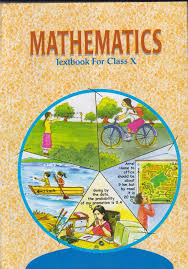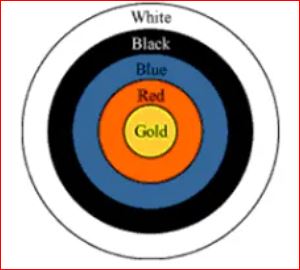Class 10 - Mathematics
Areas Related To Circles - Exercise 12.1

Top Block 1
Exercise 12.1
Question : 1:The radii of two circles are 19 cm and 9 cm respectively. Find the radius of the circle which has circumference equal to the
sum of the circumferences of the two circles.
Answer :
We have,
Radius of circle-I R1 = 19 cm
Radius of circle-II R2 = 9 cm
Circumference of circle-I = 2πR1 = 2π * 19 cm
Circumference of circle-II = 2πR2 = 2π * 9 cm
Sum of the circumferences of circle-I and circle-II = 2π * 19 + 2π * 9
= 2π(19 + 9)
= (2π * 28) cm
Let R be the radius of the circle-III.
Circumference of circle-III = 2πR
According to the condition,
2πR = 2π * 28
⇒ R = (2π * 28)/2π
⇒ R = 28
Thus, the radius of the new circle = 28 cm.
Question : 2:The radii of two circles are 8 cm and 6 cm respectively. Find the radius of the circle having area equal to the sum of the areas of the two circles.
Answer :
We have,
Radius of circle-I, r1 = 8 cm
So, Area of circle-I = πr12 = π(8)2 cm2
Area of circle-II = πr22 = π(6) 2 cm2
Let the radius of the circle-III be R
∴ Area of circle-III = πR2
Now, according to the condition,
πr12 + πr12 = πR2
⇒ π(8)2 + π(6)2 = πR2
⇒ π(82 + 62) = πR2
⇒ 64 + 36 = R2
⇒ 100 = R2
⇒ 102 = R2
⇒ R = 10
Thus, the radius of the new circle = 10 cm.
Question : 3:Fig. 12.3 depicts an archery target marked with its five scoring areas from the centre outwards as Gold, Red, Blue,
Black and White. The diameter of the region representing Gold score is 21 cm and each of the other bands is 10.5.
Answer :

Radius of the innermost (Gold Scoring) region = 21/2 = 10.5 cm
So, area of Gold region = π(10.5)2
= (22/7) * 10.5 * 10.5
= 22 * 1.5 * 10.5
= 346.50 cm2
Area of Red region = π(10.5 + 10.5)2 – π(10.5)2
= π(21)2 – π(10.5)2
= (22/7) * 21 * 21 – 346.50
= 22 * 21 * 3 – 346.50
= 1386 – 346.50
= 1039.50 cm2
Area of Blue region = π(21 + 10.5)2 – π(21)2
= π(31.5)2 – π(21)2
= π{(31.5)2 – (21)2}
= π(31.5 – 21)(31.5 + 21)
= (22/7) * 10.5 * 52.5
= 22 * 1.5 * 52.5
= 1732.50 cm2
Area of Black region = π(31.5 + 10.5)2 – π(31.5)2
= π(42)2 – π(31.5)2
= π{(42)2 – (31.5)2}
= π(42 – 31.5)(42 + 31.5)
= (22/7) * 10.5 * 73.5
= 22 * 1.5 * 73.5
= 2425.50 cm2
Area of White region = π(42 + 10.5)2 – π(42)2
= π(52.5)2 – π(42)2
= π{(52.5)2 – (42)2}
= π(52.5 – 42)(52.5 + 42)
= (22/7) * 10.5 * 94.5
= 22 * 1.5 * 94.5
= 3118.50 cm2
Mddle block 1
Question : 4:The wheels of a car are of diameter 80 cm each. How many complete revolutions does each wheel make in 10 minutes
when the car is travelling at a speed of 66 km per hour?
Answer :
Given diameter of the wheel = 80
So, the radius of the wheel r = 80/2 = 40
Now circumference of the wheel = 2πr
=2π * 40
= 80π
Now Speed of the car = 66 km/hour
= (66*1000 *100)/60
(1 km = 1000m and 1 m = 100 cm, 1 hour = 60 minutes)
= (66*1000 *10)/6 (100 and 60 is divided by 10)
= 11*10000 (66 and 6 is divided by 6)
= 110000 cm/minute
Distance travelled by car in 10 minutes = 110000*10 = 1100000 cm
Let the number of revolution of the wheel is n.
So, n * distance travelled in one minute = Distance travelled in 10 minutes
⇒ n * circumference of the wheel = Distance travelled in 10 minutes
⇒ n * 80π = 1100000
⇒ n = 1100000/80π
⇒ n = (110000)/8π (1100000 and 80 is divided by 10)
⇒ n = (110000*7)/(22*8) (π = 22/7)
⇒ n = (10000*7)/(2*8) (110000 and 22 is divided by 11)
⇒ n = (5000*7)/8 (10000 and 2 is divided by 2)
⇒ n = 625*7 (5000 and 8 is divided by 8)
⇒ n = 4375
So, the number of revolution in 10 minutes at speed of 66 km/hour is 4375
Question 5:
Tick the correct answer in the following and justify your choice:
If the perimeter and the area of a circle are numerically equal, then the radius of the circle is
(A) 2 units (B) π units (C) 4 units (D) 7 units
Answer :
We have:
Numerical area of the circle = Numerical circumference of the circle
⇒ πr2 = 2πr
⇒ πr2 – 2πr = 0
⇒ π(r2 – 2r) = 0
⇒ r2 – 2r = 0 [Since π ≠ 0]
⇒ r(r – 2) = 0
⇒ r = 0 or r = 2
But r cannot be zero
So, r = 2 units.
Thus, the option (A) is the correct answer.
Unless stated otherwise, use π = 22/7.

